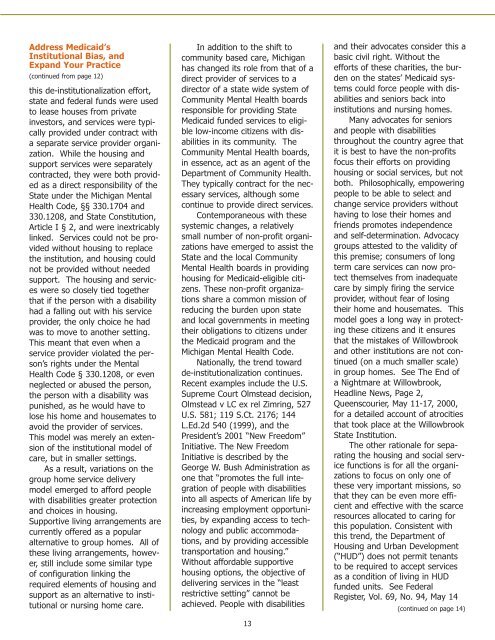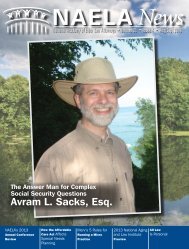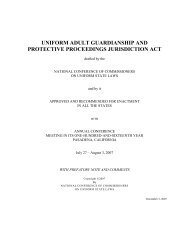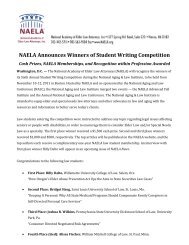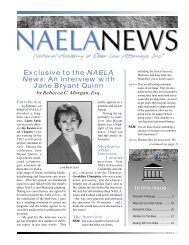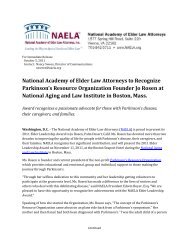N A E L A - National Academy of Elder Law Attorneys
N A E L A - National Academy of Elder Law Attorneys
N A E L A - National Academy of Elder Law Attorneys
Create successful ePaper yourself
Turn your PDF publications into a flip-book with our unique Google optimized e-Paper software.
Address Medicaid’s<br />
Institutional Bias, and<br />
Expand Your Practice<br />
(continued from page 12)<br />
this de-institutionalization effort,<br />
state and federal funds were used<br />
to lease houses from private<br />
investors, and services were typically<br />
provided under contract with<br />
a separate service provider organization.<br />
While the housing and<br />
support services were separately<br />
contracted, they were both provided<br />
as a direct responsibility <strong>of</strong> the<br />
State under the Michigan Mental<br />
Health Code, §§ 330.1704 and<br />
330.1208, and State Constitution,<br />
Article I § 2, and were inextricably<br />
linked. Services could not be provided<br />
without housing to replace<br />
the institution, and housing could<br />
not be provided without needed<br />
support. The housing and services<br />
were so closely tied together<br />
that if the person with a disability<br />
had a falling out with his service<br />
provider, the only choice he had<br />
was to move to another setting.<br />
This meant that even when a<br />
service provider violated the person’s<br />
rights under the Mental<br />
Health Code § 330.1208, or even<br />
neglected or abused the person,<br />
the person with a disability was<br />
punished, as he would have to<br />
lose his home and housemates to<br />
avoid the provider <strong>of</strong> services.<br />
This model was merely an extension<br />
<strong>of</strong> the institutional model <strong>of</strong><br />
care, but in smaller settings.<br />
As a result, variations on the<br />
group home service delivery<br />
model emerged to afford people<br />
with disabilities greater protection<br />
and choices in housing.<br />
Supportive living arrangements are<br />
currently <strong>of</strong>fered as a popular<br />
alternative to group homes. All <strong>of</strong><br />
these living arrangements, however,<br />
still include some similar type<br />
<strong>of</strong> configuration linking the<br />
required elements <strong>of</strong> housing and<br />
support as an alternative to institutional<br />
or nursing home care.<br />
In addition to the shift to<br />
community based care, Michigan<br />
has changed its role from that <strong>of</strong> a<br />
direct provider <strong>of</strong> services to a<br />
director <strong>of</strong> a state wide system <strong>of</strong><br />
Community Mental Health boards<br />
responsible for providing State<br />
Medicaid funded services to eligible<br />
low-income citizens with disabilities<br />
in its community. The<br />
Community Mental Health boards,<br />
in essence, act as an agent <strong>of</strong> the<br />
Department <strong>of</strong> Community Health.<br />
They typically contract for the necessary<br />
services, although some<br />
continue to provide direct services.<br />
Contemporaneous with these<br />
systemic changes, a relatively<br />
small number <strong>of</strong> non-pr<strong>of</strong>it organizations<br />
have emerged to assist the<br />
State and the local Community<br />
Mental Health boards in providing<br />
housing for Medicaid-eligible citizens.<br />
These non-pr<strong>of</strong>it organizations<br />
share a common mission <strong>of</strong><br />
reducing the burden upon state<br />
and local governments in meeting<br />
their obligations to citizens under<br />
the Medicaid program and the<br />
Michigan Mental Health Code.<br />
<strong>National</strong>ly, the trend toward<br />
de-institutionalization continues.<br />
Recent examples include the U.S.<br />
Supreme Court Olmstead decision,<br />
Olmstead v LC ex rel Zimring, 527<br />
U.S. 581; 119 S.Ct. 2176; 144<br />
L.Ed.2d 540 (1999), and the<br />
President’s 2001 “New Freedom”<br />
Initiative. The New Freedom<br />
Initiative is described by the<br />
George W. Bush Administration as<br />
one that “promotes the full integration<br />
<strong>of</strong> people with disabilities<br />
into all aspects <strong>of</strong> American life by<br />
increasing employment opportunities,<br />
by expanding access to technology<br />
and public accommodations,<br />
and by providing accessible<br />
transportation and housing.”<br />
Without affordable supportive<br />
housing options, the objective <strong>of</strong><br />
delivering services in the “least<br />
restrictive setting” cannot be<br />
achieved. People with disabilities<br />
13<br />
and their advocates consider this a<br />
basic civil right. Without the<br />
efforts <strong>of</strong> these charities, the burden<br />
on the states’ Medicaid systems<br />
could force people with disabilities<br />
and seniors back into<br />
institutions and nursing homes.<br />
Many advocates for seniors<br />
and people with disabilities<br />
throughout the country agree that<br />
it is best to have the non-pr<strong>of</strong>its<br />
focus their efforts on providing<br />
housing or social services, but not<br />
both. Philosophically, empowering<br />
people to be able to select and<br />
change service providers without<br />
having to lose their homes and<br />
friends promotes independence<br />
and self-determination. Advocacy<br />
groups attested to the validity <strong>of</strong><br />
this premise; consumers <strong>of</strong> long<br />
term care services can now protect<br />
themselves from inadequate<br />
care by simply firing the service<br />
provider, without fear <strong>of</strong> losing<br />
their home and housemates. This<br />
model goes a long way in protecting<br />
these citizens and it ensures<br />
that the mistakes <strong>of</strong> Willowbrook<br />
and other institutions are not continued<br />
(on a much smaller scale)<br />
in group homes. See The End <strong>of</strong><br />
a Nightmare at Willowbrook,<br />
Headline News, Page 2,<br />
Queenscourier, May 11-17, 2000,<br />
for a detailed account <strong>of</strong> atrocities<br />
that took place at the Willowbrook<br />
State Institution.<br />
The other rationale for separating<br />
the housing and social service<br />
functions is for all the organizations<br />
to focus on only one <strong>of</strong><br />
these very important missions, so<br />
that they can be even more efficient<br />
and effective with the scarce<br />
resources allocated to caring for<br />
this population. Consistent with<br />
this trend, the Department <strong>of</strong><br />
Housing and Urban Development<br />
(“HUD”) does not permit tenants<br />
to be required to accept services<br />
as a condition <strong>of</strong> living in HUD<br />
funded units. See Federal<br />
Register, Vol. 69, No. 94, May 14<br />
(continued on page 14)


